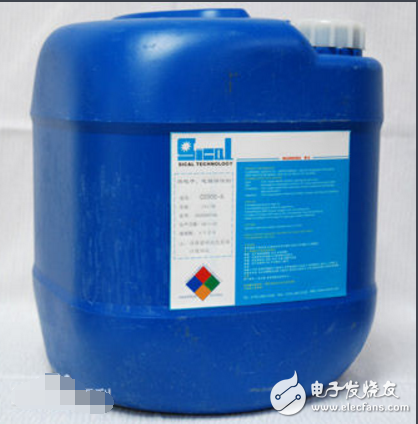Flux is widely used in the PCB industry, and its quality directly affects the entire production process and product quality of the electronics industry. With the implementation of the RoHS and WEEE directives, lead-free has put forward higher requirements for the performance of flux. The flux has evolved from the traditional rosin type to halogen-free, rosin-free, no-clean, low solid content. Corresponding changes have also taken place, and the interaction of the components makes the performance of the flux more excellent.
Flux is usually a mixture of rosin as a main component and is an auxiliary material to ensure smooth welding. Welding is the main process in electronic assembly. Flux is the auxiliary material used in soldering. The main function of flux is to remove the oxide and the oxide on the surface of the soldered base material to achieve the necessary cleanliness of the metal surface. It prevents reoxidation of the surface during soldering, reduces solder surface tension and improves solderability. The quality of the flux directly affects the quality of the electronic product.

Fluxes at home and abroad generally consist of activators, solvents, surfactants and special ingredients. Special ingredients include corrosion inhibitors, antioxidants, film formers, and the like.
Flux compositionIn recent decades, in the soldering process for the production of electronic products, a rosin resin-based flux mainly composed of rosin, a resin, a halide-containing active agent, an additive, and an organic solvent has been generally used. Although such fluxes have good solderability and low cost, they have high residue after soldering. The residue contains halogen ions, which gradually causes problems such as deterioration of electrical insulation performance and short circuit. To solve this problem, it is necessary to clean the rosin resin flux residue on the electronic printed board. This not only increases the production cost, but also the cleaning agent for cleaning the rosin resin flux residue is mainly a chlorofluoro compound. This compound is a depleted substance in the ozone layer of the atmosphere and is classified as banned and eliminated. There are still many companies that follow the process of cleaning with the rosin tree finger flux solder and cleaning agent, which is low in efficiency and high in cost.
The main raw materials of the no-clean flux are organic solvents, rosin resins and their derivatives, synthetic resin surfactants, organic acid activators, anticorrosive agents, cosolvents, and film formers. Briefly, various solid components are dissolved in various liquids to form a uniformly transparent mixed solution in which the proportions of the various components are different and function differently.
Organic solvent: one or a mixture of ketones, alcohols, esters, commonly used are ethanol, propanol, butanol; acetone, toluene isobutyl ketone; ethyl acetate, butyl acetate and the like. As a liquid component, its main function is to dissolve the solid component in the flux to form a uniform solution, which is convenient for uniformly coating the flux component with a proper amount of flux component, and it can also clean light dirt and oil stain on the metal surface. .
Natural resin and its derivatives or synthetic resins
Surfactant: Halogen-containing surfactant has high activity and high fluxing ability, but it is difficult to clean due to halogen ions, high ion residue, and halogen element (mainly chloride) is highly corrosive, so it is not suitable for use. The raw material of the no-clean flux, the halogen-free surfactant, has a slightly weaker activity, but has less ion residue. The surfactant is mainly a fatty acid group or an aromatic nonionic surfactant, and its main function is to reduce the surface tension generated when the solder contacts the lead metal, enhance the surface wetting force, and enhance the organic acid activator. Penetration, also acts as a blowing agent
Organic acid activator: composed of one or more of an organic acid dibasic acid or an aromatic acid, such as succinic acid, glutaric acid, itaconic acid, o-hydroxybenzoic acid, azelaic acid, pimelic acid, apple Acid, succinic acid, etc. Its main function is to remove oxides on the lead pins and oxides on the surface of the molten solder, which is one of the key components of the flux.
Anticorrosive agent: Reducing substances remaining after solid decomposition of solid components such as resins and activators
Cosolvent: Prevents the tendency of solid components such as activators to be desolvated from solution, and avoids non-uniform distribution of activator
Film Forming Agent: During the soldering process of the lead pin, the coated flux precipitates and crystallizes to form a uniform film. The residue after high temperature decomposition can be quickly solidified, hardened and reduced due to the presence of a film former. viscosity.
We've been around for over 16+ years. We make sure our sound is The Best Sound.
Our products include gaming headset, Bluetooth Earphone, Headphones Noise Cancelling, Best Wireless Earbuds, Bluetooth Mask, Headphones For Sleeping, Headphones in Headband, Bluetooth Beanie Hat, bluetooth for motorcycle helmet, etc
Manufacturing high-quality products for customers according to international standards, such as CE ROHS FCC REACH UL SGS BQB etc.
We help 200+ customers create custom Bluetooth headphones, earbuds, earphones, etc audio products design for various industries.
Customized Headphones, personalized gifts, promotional products custom , Bluetooth Earphones,Best Headphones
TOPNOTCH INTERNATIONAL GROUP LIMITED , https://www.mic11.com